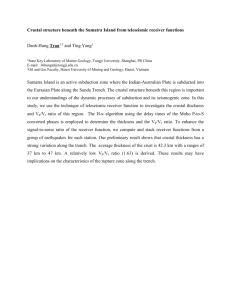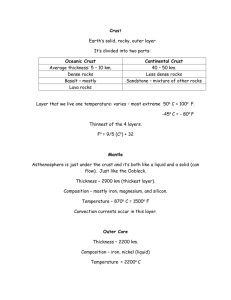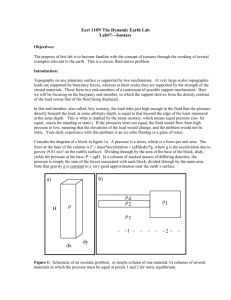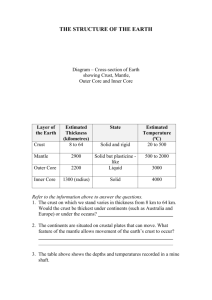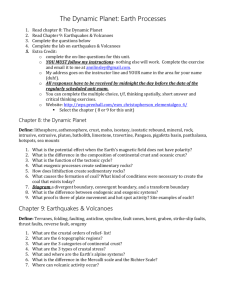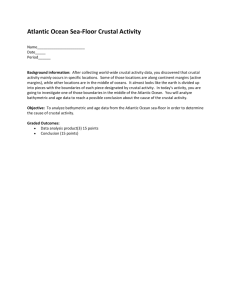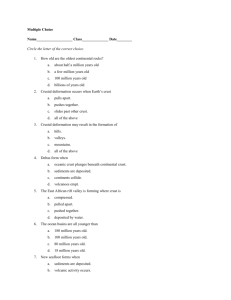Rayleigh wave dispersion measurements reveal low velocity zones
advertisement
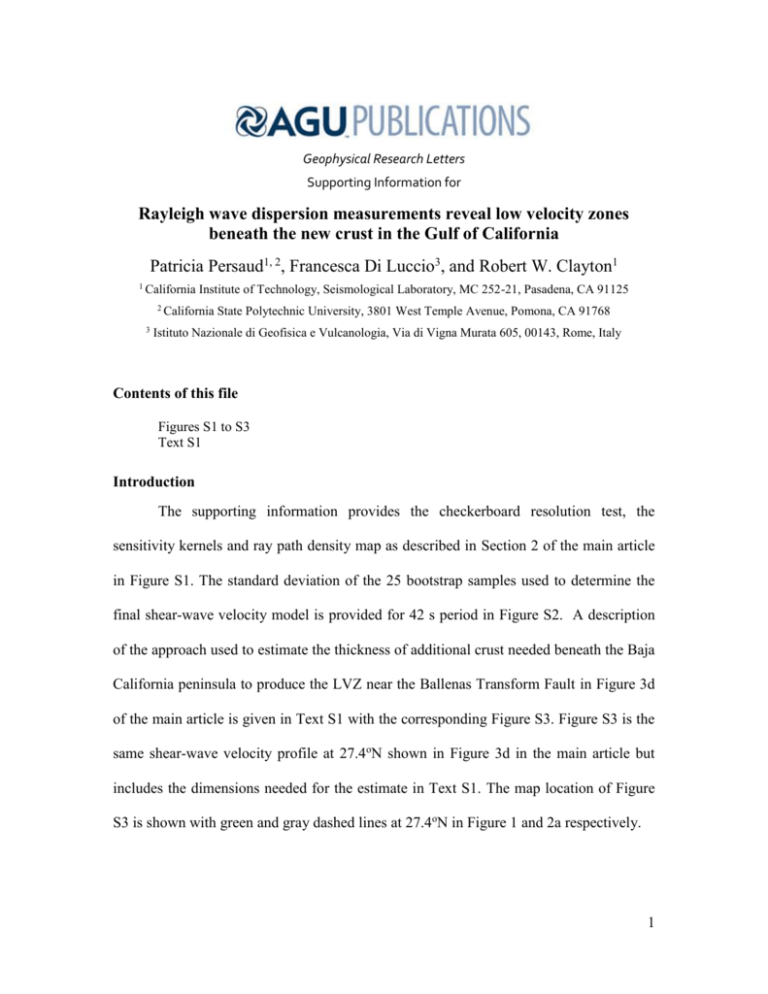
Geophysical Research Letters Supporting Information for Rayleigh wave dispersion measurements reveal low velocity zones beneath the new crust in the Gulf of California Patricia Persaud1, 2, Francesca Di Luccio3, and Robert W. Clayton1 1 California Institute of Technology, Seismological Laboratory, MC 252-21, Pasadena, CA 91125 2 3 California State Polytechnic University, 3801 West Temple Avenue, Pomona, CA 91768 Istituto Nazionale di Geofisica e Vulcanologia, Via di Vigna Murata 605, 00143, Rome, Italy Contents of this file Figures S1 to S3 Text S1 Introduction The supporting information provides the checkerboard resolution test, the sensitivity kernels and ray path density map as described in Section 2 of the main article in Figure S1. The standard deviation of the 25 bootstrap samples used to determine the final shear-wave velocity model is provided for 42 s period in Figure S2. A description of the approach used to estimate the thickness of additional crust needed beneath the Baja California peninsula to produce the LVZ near the Ballenas Transform Fault in Figure 3d of the main article is given in Text S1 with the corresponding Figure S3. Figure S3 is the same shear-wave velocity profile at 27.4oN shown in Figure 3d in the main article but includes the dimensions needed for the estimate in Text S1. The map location of Figure S3 is shown with green and gray dashed lines at 27.4oN in Figure 1 and 2a respectively. 1 Figure S1. 2 Figure S1. Checkerboard resolution test for Rayleigh-wave group velocities at different periods (17, 22, 28, 36, and 42 s, labeled in five colored map panels), corresponding to the shear-wave tomographic maps shown in Figure 2 of the main article. The 2D checkerboard sinusoid input model of ~1.5◦ × ~1.5◦ checkers is shown in the top left panel. The number of crossing ray-paths in each cell is also plotted in the bottom right panel. Depth sensitivity kernels of the fundamental-mode Rayleigh wave group velocities with respect to shear-wave velocity at the indicated periods are shown in the bottom left panel. Figure S2. Map showing the standard deviation at 42 s period of 25 bootstrap samples of the Rayleigh-wave group velocity data set. For each bootstrap sample, we performed the tomographic inversion and calculated the cell mean and standard deviation. The results show <0.16 km/s standard deviation for most of the study area. Pink line marks the plate boundary. 3 Figure S3. Profile of our shear-wave velocity model at 27.4oN (same as Figure 3d) showing the average shear-wave speeds and the dimensions used to calculate X, the thickness of extra crust needed beneath the Baja California peninsula to produce the LVZ. The boundary between the western and eastern PRB is estimated based on the magnetic potential data of Langenheim and Jachens [2003] shown in Figure 1 of the main article. The crustal thickness of the western and eastern PRB are based on receiver function results from nearby NARS-Baja stations [Persaud et al., 2007]. Regions of asthenospheric upwelling [Di Luccio et al., 2014] are shown with white arrows. Black arrow indicates possible lower crustal flow. Text S1. Estimate of the additional crustal thickness needed beneath the Baja California peninsula to produce the LVZ near the Ballenas Transform Fault We use the shear-wave velocity profile shown in Figure 3d in the main article to estimate X, the additional continental crustal thickness beneath the Baja California peninsula needed to produce the same cross-sectional area of crust in the LVZ beneath the Gulf. Based on their low velocities of 3.6–3.8 km/s similar to continental crust and their 4 geometry in the shear-wave profiles (Figures 3a, 3c, and 3d in the main article), the shallow LVZs appear to be connected to the middle crust in the continental margins of the Gulf, though this is based on seismic velocities alone and their proximity to the continental edges and does not represent a real connection. It should be noted that this profile is not perpendicular to the rift axis; however, given the transtensional setting of the Gulf and the lateral translation of the Baja peninsula, we do not expect that a profile perpendicular to the rift axis will give a more accurate estimate than the one we provide here as significant along-strike offsets are expected. Due to the noted decrease in crustal thickness from west to east across the peninsula [Lewis et al., 2001] and based on the limited number of receiver function estimates [Persaud et al., 2007] shown in color at each station in Figure 1 of the main article, we split the continental crust there in two domains. We assume that roughly one half of the continental crust in the cross-section is the thinner eastern Peninsular Ranges batholith (PRB) and the other half is thicker western PRB (Figure S3). This compositional boundary is based on the pseudogravity (magnetic potential) results of [Langenheim and Jachens, 2003] shown in Figure 1, with the higher and lower magnetic potential being representative of the western PRB and eastern PRB respectively. We use the crustal thickness estimates of Persaud et al. [2007] from nearby NARS-Baja stations, NE75 (27.6 km) and NE76 (20.9 km) as representative of the western and eastern PRB respectively. In addition, we make a conservative estimate of the western margin of the western PRB and do not include the thinner crust in the Vizcaino peninsula southwest of NE74 (see Figure 1 for location). Although the crustal thicknesses along the profile vary more continuously than in our estimate, the sparse broadband station density along the peninsula allows only a first-order estimate. 5 The specific geometry for our estimate is shown in Figure S3 with the regions of eastern and western PRB and the LVZ highlighted. We estimate X as follows: additional area beneath the Baja peninsula (pink box in Figure S3) = area of the LVZ in the Gulf (blue box in Figure S3) 88X +88X +88× ( 27.6 - 20.9) km2 =14×134km2 X » 10 km This suggests that the initial crustal thickness beneath the Baja peninsula in this region was roughly ~37.6 km (= 27.6 + 10 km) if the eastern and western PRB had the same initial thickness. References Di Luccio, F., P. Persaud, and R. W. Clayton (2014), Seismic structure beneath the Gulf of California: a contribution from group velocity measurements, Geophysical Journal International, 199(3), 1861-1877. Langenheim, V. E., and R. C. Jachens (2003), Crustal structure of the Peninsular Ranges Batholith from magnetic data; implications for Gulf of California rifting, Geophysical Research Letters, 30(11), 4. Lewis, J. L., S. M. Day, H. Magistrale, R. R. Castro, L. Astiz, C. Rebollar, J. Eakins, F. L. Vernon, and J. N. Brune (2001), Crustal thickness of the Peninsular Ranges and Gulf Extensional Province in the Californias, Journal of Geophysical Research: Solid Earth, 106(B7), 13599-13611. Persaud, P., X. Perez-Campos, and R. W. Clayton (2007), Crustal thickness variations in the margins of the Gulf of California from receiver functions, Geophysical Journal International, 170(2), 687-699. 6

